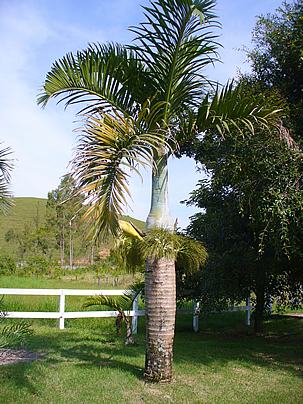The Spindle Palm (Hyophorbe verschaffeltii) is a stunning sculptural palm, with a single stem that, true to its name, has a fusiform shape, thickened at the base, slightly narrowing, and then thickening again, leading to a narrower crownshaft at the top. It is native to Rodrigues Island, located in the Mascarene Archipelago in the Indian Ocean. There, it is seriously endangered, with only 50 or fewer specimens remaining in the wild. Despite this, it is a palm cultivated in tropical regions around the world for its ornamental qualities.
Its trunk is grayish, ringed due to the scars of fallen leaves, and about 10 inches (25 centimeters) in diameter. The leaves are pinnate, ascending, erect to arched, and emerge, in a number of six to ten, at the apex of a long and apparent grayish-green crownshaft. In young plants, and when not peeled, a beautiful pattern from the remaining petioles is left on the trunk. The inflorescences emerge at the base of the crownshaft, and the initial sprouts resemble pointed horns. They are of the spike type and contain small and numerous flowers, of an orange-yellow color, fragrant. The fruits are black, ellipsoid drupes with juicy pulp.

In landscaping, the spindle palm is still underutilized, being more common in botanical collections. The spindle palm can be used singly, highlighting its sculptural aspect as a focal point, or in groups and rows along pathways. It adds tropical beauty and elegance to various settings, when planted in pots or indoor gardens under skylights or transparent roofs.
For this reason, it is interesting for use in large halls, lobbies, and shopping centers. Its initial growth is quite slow, allowing it to be used as foliage in well-lit interiors in the early years. Each year it becomes more vigorous, and its growth accelerates. It is quite hardy and low maintenance.
It should be grown under partial shade or full sun, in preferably well-drained, fertile soil enriched with organic matter, and watered regularly, especially in the first years of establishment. The spindle palm is quite sensitive to intense cold (below 0°C or 32ºF) or frost, but there are reports of many plants thriving in subtropical climates successfully.
It is advisable to protect it from severe frost if possible, by covering or bringing it indoors if grown in pots. The spindle palm is ideal for coastal regions, as it has excellent tolerance to salinity and waterlogging. It multiplies by fresh seeds, harvested when ripe, depulped, cleaned, dried, and germinated in a sandy substrate kept moist. Germination can take from 40 days to 4 months to complete.


